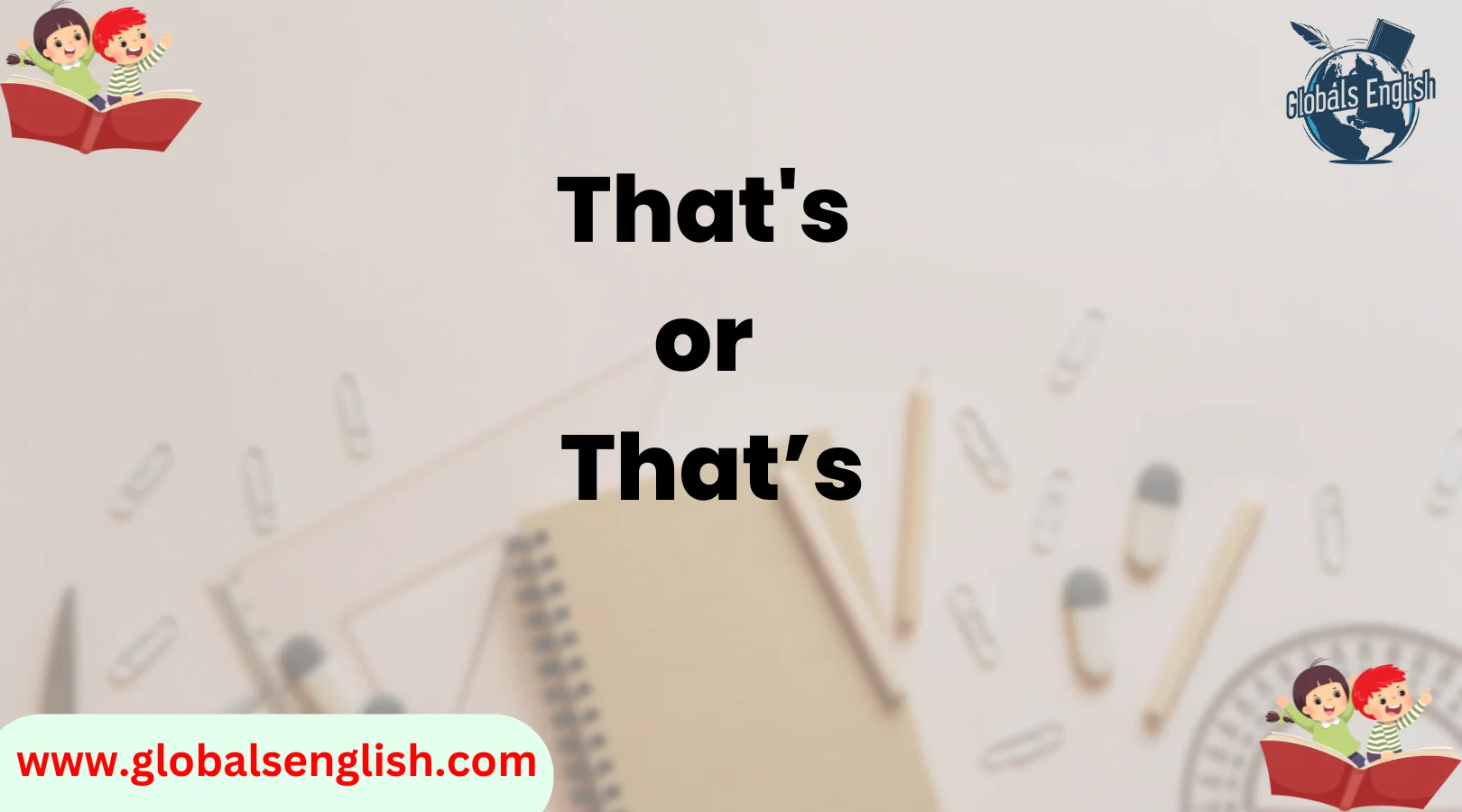When it comes to mastering grammar, the difference between “that’s” and “that’s” can often be a tricky point of confusion for many people. In reality, both forms appear to be exactly the same. So, how can we differentiate them in usage? Understanding the distinction between “that’s” and “that’s” will not only improve your writing skills but will also ensure you come across as clear, authoritative, and professional in both written and spoken communication.
In this article, we will dissect the two terms and provide actionable tips on how to use them correctly. We’ll explore their grammatical structure, common mistakes, and share insights into why getting them right matters—particularly for enhancing your communication, whether it’s for formal writing, emails, or casual conversations.
By the end of this article, you’ll feel confident about your ability to distinguish between “that’s” and “that’s”, and you’ll understand why correct grammar builds trust with your audience. Let’s dive right in and clear up any confusion!
Introduction: Understanding the Difference Between “That’s” and “That’s”
At first glance, the words “that’s” and “that’s” appear identical, but these two forms serve very distinct grammatical purposes. The confusion stems from the fact that “that’s” is a contraction—a shortened version of a longer phrase—and the specific phrase it contracts can differ based on context. This leads to occasional mistakes that can undermine the clarity of your writing.
So, which one is correct? The short answer is that both forms are correct—as long as you use them in the proper context. But here’s the kicker: misusing these contractions can make your writing sound awkward or, worse, unprofessional.
What Exactly Is a Contraction?
Before diving into the specifics of “that’s” and “that’s”, let’s take a quick refresher on what contractions are in English. Contractions occur when two words are combined and shortened, typically using an apostrophe. For example:
- “I am” becomes “I’m.”
- “They are” becomes “They’re.”
- “It is” becomes “It’s.”
In both formal and informal writing, contractions are often used to make language flow more naturally and sound conversational. The key, however, is knowing when to use them and in what context, which is why it’s crucial to understand the proper use of “that’s”.
The Basics: What Is “That’s” and What Does It Mean?
In its simplest form, “that’s” is the contraction for either “that is” or “that has.” The apostrophe represents the missing letters, making the sentence sound more fluid and less formal. Here’s how they break down:
- “That’s” = “That is”
Example: “That’s a beautiful painting.” (Here, “that’s” stands for “that is.”) - “That’s” = “That has”
Example: “That’s been a long time.” (Here, “that’s” stands for “that has.”)
The key difference lies in the context of the sentence. Both phrases can stand alone without altering their meaning, but recognizing which form of “that’s” you are using can prevent any misunderstanding.
Grammatical Structure: How “That’s” Functions in Sentences
When you write or speak, it’s important to recognize how “that’s” functions in relation to the rest of the sentence.
- “That’s” as “That is”
In most cases, when we use “that’s” as a contraction for “that is,” it serves as a linking verb, connecting the subject of the sentence with a description or explanation.
Example: “That’s the house I grew up in.”
Here, “that’s” connects the subject (“that”) with the complement (“the house I grew up in”), forming a clear and concise statement. - “That’s” as “That has”
When “that’s” stands for “that has,” it’s typically used to describe an action or a state of being that started in the past and continues into the present.
Example: “That’s been a great experience.”
In this case, “that’s” represents “that has”, indicating something that happened and still holds relevance.
Tips for Identifying Which Form of “That’s” to Use
- If you’re describing something or making a general statement, it’s most likely “that is.”
- If you’re referring to something that happened or has been the case over time, it’s most likely “that has.”
“That’s” vs “That’s”: When to Use Each in Context
Now that we understand the basics of “that’s”, it’s time to break down specific usage cases for each form. Context plays a vital role in determining which version of “that’s” is appropriate for the sentence.
Using “That’s” for “That is”
- Example: “That’s what I was trying to say.”
- Here, “that’s” is short for “that is,” and we’re explaining or identifying something.
- Here, “that’s” is short for “that is,” and we’re explaining or identifying something.
- Example: “That’s a great idea!”
- Again, “that’s” is standing in for “that is,” offering an affirmative statement.
- Again, “that’s” is standing in for “that is,” offering an affirmative statement.
Using “That’s” for “That has”
- Example: “That’s been a great trip.”
- In this example, “that’s” refers to “that has,” implying the experience of the trip is still relevant or ongoing.
- In this example, “that’s” refers to “that has,” implying the experience of the trip is still relevant or ongoing.
- Example: “That’s never been an issue.”
- Here, “that’s” is short for “that has,” describing an issue that has not occurred in the past and doesn’t seem likely to in the future.
- Here, “that’s” is short for “that has,” describing an issue that has not occurred in the past and doesn’t seem likely to in the future.
Common Mistakes: Misusing “That’s” and “That’s”
Even seasoned writers make mistakes with contractions, so it’s important to be aware of common errors. Here are some of the most frequent missteps people make with “that’s”:
Overusing Contractions in Formal Writing
In formal settings—such as business emails, academic essays, or professional reports—using contractions like “that’s” can appear too casual. If your goal is to maintain a more formal tone, it’s often better to use “that is” or “that has” instead of their contracted forms.
Confusing “That’s” for “Its”
While it’s tempting to use “that’s” when you mean “its,” these two terms are not interchangeable. “Its” is a possessive form of “it,” whereas “that’s” is a contraction for “that is” or “that has.”
The Impact of “That’s” on Formal and Informal Communication
Using contractions like “that’s” can make a big difference in the tone of your communication. In informal settings, such as personal emails, text messages, and casual conversations, using contractions can make your language sound more natural and approachable.
On the other hand, in formal writing, such as academic papers or professional documents, it’s often best to avoid contractions, as they can make your work seem less polished or authoritative.
How to Decide When to Use “That’s”
- Informal Writing: It’s perfectly fine to use “that’s” in personal blogs, social media posts, and casual emails.
- Formal Writing: For academic papers, resumes, or professional correspondence, opt for “that is” or “that has” to maintain a formal tone.
“That’s” in Writing: How to Use It Effectively in Different Forms of Writing
Understanding how “that’s” works can be a huge asset in various forms of writing. Whether you’re composing a blog post, email, or even creative writing, knowing when to use “that’s” will make your language more fluid and natural.
In Essays and Articles
In formal essays or articles, using “that’s” can sound conversational but may need to be avoided in more serious, academic contexts. For example, use the full form “that is” or “that has” when you need to maintain a more serious or professional tone.
Frequently Asked Questions (FAQs) About “That’s”
Here are the most common questions people have about “that’s” and how to use it correctly in different contexts.
1. What is the difference between “that’s” and “that’s”?
There is no difference between “that’s” and “that’s”—both are contractions for either “that is” or “that has.” The apostrophe placement remains the same, and they function identically in writing and speech. The key is knowing when to use “that is” versus “that has” in a sentence.
2. When should I use “that’s” in a sentence?
Use “that’s” whenever you want a shortened version of “that is” or “that has.” Here are some examples:
- “That’s a fantastic idea!” (That is a fantastic idea!)
- “That’s been a long journey.” (That has been a long journey.)
3. Is “that’s” formal or informal?
“That’s” is considered informal because contractions are typically used in casual speech and writing. In formal writing, such as academic papers or business reports, it’s usually better to write out the full form:
- Formal: That is the policy we follow.
- Informal: That’s the policy we follow.
4. Can “that’s” be used in academic writing?
It’s generally not recommended to use contractions like “that’s” in academic or professional writing. Instead, write the full version:
- Incorrect (in formal writing): That’s why research is important.
- Correct (in formal writing): That is why research is important.
5. What’s the difference between “that’s” and “its”?
These two words are often confused, but they serve different grammatical purposes:
- “That’s” = contraction for “that is” or “that has.” (That’s incredible! → That is incredible.)
- “Its” = possessive form of “it.” (The dog wagged its tail. → Shows possession.)
Conclusion: Mastering “That’s” for Clear and Effective Communication
Understanding how to use “that’s” correctly is an important step toward improving your writing. Whether you’re aiming for clarity, professionalism, or informality, knowing when to use “that’s” versus “that’s” will elevate your language skills.
By avoiding common mistakes and mastering this simple contraction, you’ll be able to communicate more effectively and with confidence. So, next time you’re writing an email or crafting a social media post, pay attention to which form of “that’s” you use—it’s the little things that make a big difference in how others perceive your communication!

Emma Brooke is the author and creator behind Globals English, a platform dedicated to helping learners master the English language. With a passion for education and communication, Emma brings years of experience in language teaching and curriculum development. Her mission is to make English learning accessible, engaging, and effective for students worldwide.
